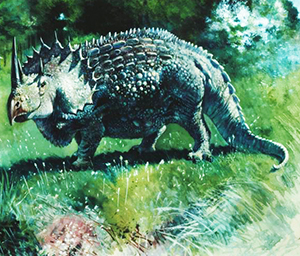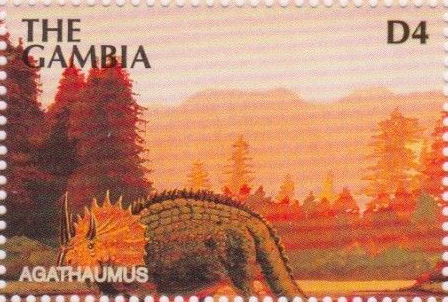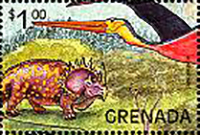Agathaumas sylvestris Cope, 1872

(Da: it.wikipedia.org)
Phylum: Chordata Haeckel, 1874
Subphylum: Vertebrata Cuvier, 1812
Classe: Dinosauria Owen, 1841
Ordine: Ornithischia Seeley, 1888
Famiglia: Ceratopsidae Marsh, 1890
Genere: Agathaumas Cope, 1872
Descrizione
È un dinosauro praticamente sconosciuto, ma di grande importanza storica. È infatti uno dei primi dinosauri cornuti (Ceratopsidi) ad essere stato scoperto, nel 1872, nel Wyoming sudoccidentale, da F. B. Meek; il suo nome significa "grande meraviglia". In realtà l'autore del ritrovamento, Edward Drinker Cope, pensava che l'Agathaumas, noto solo per alcune grandi ossa della colonna vertebrale rinvenute in strati del Cretacico superiore (Maastrichtiano, tra 70,6 e 66,043 milioni di anni fa) degli Stati Uniti, fosse un dinosauro a becco d'anatra particolarmente robusto. Solo con la scoperta del ben noto Triceratops da parte di Othniel Charles Marsh, avvenuta nel 1889, fu chiara l'appartenenza di queste ossa. L'Agathaumas, comunque, rimane un nomen dubium, anche se è chiara la sua classificazione come ceratopside. Attualmente si sa relativamente poco su questa specie, perché gli unici fossili trovati appartengono alla parte posteriore del dinosauro, gambe comprese.
Diffusione
I suoi resti sono stati rinvenuti negli Stati Uniti in strati del Cretacico superiore (Maastrichtiano, tra 70,6 e 66,043 milioni di anni fa).
Bibliografia
–Breithaupt, B.H. (1999). "First Discovery of Dinosaurs in the American West." Pp. 59-65 in Gillette, D.D. (ed.), Vertebrate Paleontology In Utah. Utah Geological Survey. ISBN 1-55791-634-9, ISBN 978-1-55791-634-1.
–Breithaupt, B.H. (2001). "Passport-In-Time Microvertebrate Fossil Project at the University of Wyoming Geological Museum: Late Cretaceous Paleontological Resources in the Public Eye." Pp. 107-112 in Santucci, V.L., and McClelland, L. (eds.), Proceedings of the 6th Fossil Resources Conference, United States Department of Interior - National Park Services - Geological Resources Division.
–Cope, E.D. (1872). "On the existence of Dinosauria in the Transition Beds of Wyoming." Proceedings of the American Philosophical Society, 12: 481-483.
–Cope, E.D. (1873). "The monster of Mammoth Buttes." Pennsylvania Monthly, 4: 521-534.
–Cope, E.D. (1889). "The horned Dinosauria of the Laramie." The American Naturalist, 23: 715-717.
–Burkhardt, R., 1892. "Das Gehirn von Agathaumas flabellatus Marsh". Neues Jahrbuch für Mineralogie, Geologie und Paläontologie 1892: 71-72.
– Ballou, W.H., 1897. "Strange creatures of the past, Gigantic saurians of the reptilian age", Century Magazine (New Series) XXXIII o.s. LV 15-23.
–AMNH, Department of Vertebrate Paleontology. (1904). "Review List of Casts, Models, and Photographs of fossil Vertebrates." Supplement to Bulletin of the American Museum of Natural History, vol. 20.
–Sternberg, C. H. (1914). Notes on the Fossil Vertebrates Collected on the Cope Expedition to the Judith River and Cow Island Beds, Montana, in 1876. Science, 134-135.
–http://silentmoviemonsters.tripod.com/TheLostWorld/LWDELGADO.html.

|
Data: 23/06/1997
Emissione: Dinosauri Stato: Gambia |
|---|

|
Data: 01/09/1999
Emissione: Dinosauri Stato: Grenada |
|---|